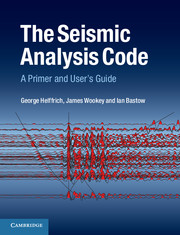Book contents
- Frontmatter
- Contents
- Preface
- Acknowledgements
- 1 Introduction
- 2 The SAC data format
- 3 The SAC processing philosophy
- 4 Basic SAC commands
- 5 SAC macros
- 6 Accessing SAC functionality and data from external programs
- 7 Graphical data annotation
- 8 Array data handling
- 9 Spectral estimation in SAC
- 10 Three-dimensional data in SAC
- 11 Implementation of common processing methodologies using SAC
- Appendix A Alphabetical list of SAC commands
- Appendix B Keyword in context for SAC command descriptions
- References
- Index
- Plate Section
11 - Implementation of common processing methodologies using SAC
Published online by Cambridge University Press: 05 October 2013
- Frontmatter
- Contents
- Preface
- Acknowledgements
- 1 Introduction
- 2 The SAC data format
- 3 The SAC processing philosophy
- 4 Basic SAC commands
- 5 SAC macros
- 6 Accessing SAC functionality and data from external programs
- 7 Graphical data annotation
- 8 Array data handling
- 9 Spectral estimation in SAC
- 10 Three-dimensional data in SAC
- 11 Implementation of common processing methodologies using SAC
- Appendix A Alphabetical list of SAC commands
- Appendix B Keyword in context for SAC command descriptions
- References
- Index
- Plate Section
Summary
SEISMIC ANISOTROPY AND SHEAR WAVE SPLITTING
Overview
The observation of two independent, orthogonally polarized shear waves, one traveling faster than the other, is arguably the most unambiguous indicator of wave propagation through an anisotropic medium. The splitting can be quantified by the time delay (δt) between the two shear waves and the orientation (φ) of the fast shear wave (Fig. 11.1).
In this chapter, we review briefly the theory behind shear wave splitting, with particular focus on the popular method of Silver and Chan (1991), for which we provide source code and documentation.
SHEAR WAVE SPLITTING ANALYSIS
Seismic anisotropy can be studied via shear wave splitting throughout the Earth, ranging in depth from hydrocarbon reservoirs in the shallow crust (e.g., Verdon et al., 2009) to the core and deep mantle (e.g., Wookey and Helffrich, 2008). By selecting earthquakes at angular distances ≥88° from a recording site, phases such as SKS, PKS and SKKS can be readily isolated for analysis of upper mantle anisotropy (for a review, see Savage, 1999). We will focus on analysis of these core phases here.
Patterns of seismic anisotropy can develop due to the preferential alignment of minerals in the crust and/or mantle, the preferential alignment of fluid or melt, layering of isotropic materials, or some combination thereof (e.g., Blackman and Kendall, 1997).
- Type
- Chapter
- Information
- The Seismic Analysis CodeA Primer and User's Guide, pp. 123 - 134Publisher: Cambridge University PressPrint publication year: 2013

